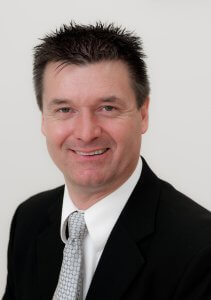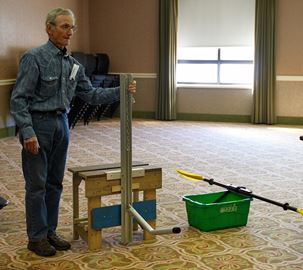
Ralph Wirsig, inventor of the KayaArm and KayaLeg
The kayak launch stabilizing devices for easy entry/exit at your dock and/or at a shore
(KayaArm: Canadian Patent No. 2,706,497, US Patent No. 8,381,673)
(KayaLeg: Canadian Patent No. 2,768,114. US Patent No. 8,915,207)
Company began as a labour of love
KayaArm™ inventor motivated by a desire to help his wife “keep on paddling”
They say necessity is the mother of invention, but for retired mechanical engineer Ralph Wirsig, designing his revolutionary KayaArm™ kayak launch system was also an affair of the heart.
His wife, Kathy, loved to kayak with him on the Eastern Ontario lake where they’d built their dream home, 30 km north of Kingston. When Kathy began to have problems getting into and out of her kayak, Ralph’s inventor antennae went up.
“My dad was insatiably curious and always thought there must be a better way,” says son Jay, who now runs the family business with his wife, Margo. “His number one reason for designing the KayaArm was so that he and my mother could continue to enjoy their early morning and late evening paddles together.”
An R&D Engineer for more than 36 years at the DuPont Canada Research and Development Centre in Kingston, Ralph had led and contributed to several national and international patents. His job was to generate innovative ideas that could be developed, patented, and eventually marketed.
Now, faced with a challenge on the home front, Ralph marshaled his training, expertise, and dogged determination to find a solution. Working on stabilization concepts, he methodically researched and revised his plans and then fabricated an aluminum prototype. Finally, he had a working model for his wife to test.
“It was perfect for me,” says Kathy Wirsig now. “I just stepped into the kayak, and away I went. Then coming back, I would paddle my kayak up on the KayaArm and step out onto the dock. No more spills!” she laughs.
Having a stress-free way to enter and exit her kayak meant Kathy could continue pursuing her passion for bird-watching – especially the loons that returned each year to their lake. Her inventor husband, aided by granddaughter Emma, had even designed and built a loon nesting platform in a secluded area safe from predators. “We were able to kayak over and observe them from the water,” says Kathy. “It was wonderful!”
A new company is launched
After his wife had used the kayak launch system successfully and others expressed a keen interest in it, Ralph’s entrepreneurial instincts were kindled. As a young man toiling in his family’s sawmill business on Kootenay Lake, B.C., he’d learned firsthand what hard work could accomplish. He often credited the success of his later business ventures to a combination of passion and “sweat equity” to get the job done.
Ralph’s son, Jay, also a mechanical engineer, connected him with a Kingston manufacturing company, Pure Ingenuity, which specializes in high-grade equipment for the food and pharmaceutical sectors. What had started as a gift to his wife began to sprout wings of its own.
A lifelong promoter of outdoor recreation, Ralph had always believed that mental and physical health were inextricably linked. If commercializing his invention could make kayaking easier and more accessible to people, he considered it a project worth pursuing.
Over the next year, Ralph focused on patenting and demonstrating his device to kayak outfitters. Blown away by its simple but effective design, ease of installation, and “uncluttered” appearance on a dock, they were eager to carry the new product in their shops. But where it ultimately took flight was on the Internet.
With help from Creative Web Designs – owned by a friend of his daughter, Susan – Ralph set up a KayaArm website and soon began receiving queries from across North America. As well as individuals and families kayaking in cottage country, it caught the attention of homeowners along coastal waterways and inland canals, whose docks were often elevated several feet above the water. “People said it was like a ‘Eureka moment’ when they tried the KayaArm for themselves,” Ralph reported.
Passing of the torch
Sadly, in March 2018, Ralph Wirsig suffered a massive brain aneurism while filling a customer order. Devastated by their loss, his family took comfort in the thought that he’d been doing what he loved: helping people to enjoy the outdoors through physical exercise.
After running KayaArm for Kathy during the summer following Ralph’s death, Jay and Margo retired from their professional careers and purchased the company from her. Under their management and with assistance from a small business support network, it has grown to become the top-selling kayak launch stabilizing device in North America.
“Not only has KayaArm provided rewarding full-time work for both of us, but our four daughters have also become involved in all aspects of the business, living and learning the customer satisfaction experience,” says Jay. “Our family dinners can sometimes become board meetings,” he jokes. One daughter, Heidi, completed an internship at KayaArm’s manufacturer as part of her Mechanical Engineering studies.
When the COVID pandemic struck in early 2020, closing indoor gyms and training facilities, people looked for alternative ways to exercise safely. Like other outdoor recreational activities, kayaking boomed – and so did KayaArm. As well as reaching a global market online, being an e-commerce business enabled the company to keep prices down, says Jay. “Now we’re exporting products around the world. KayaArm has moved well beyond the start-up phase!”
Why are kayakers drawn to KayaArm?
The secret to KayaArm’s success is threefold: It’s simple to use, reasonably priced, and easy to install.
While nominally aimed at recreational kayakers who have difficulty entering and exiting – due to balance or flexibility issues, reduced upper body strength, or other physical reasons – KayaArm offers extra convenience and safety for any user. “Our kids have never kayaked without KayaArm!” laughs Jay.
Even seasoned, athletic kayakers who prefer the “paddle bridge” approach for kayak entry/exit may be thwarted by docks that are too high. Fixed docks, where fluctuating water levels result in more than a few inches of height difference between the top of the kayak and the top of the dock, present a challenge. With its adjustable arm height feature, KayaArm eliminates this issue.
On all types of docks – from fixed to floating, from plastic to wood or metal – KayaArm is very simple to install. For many clients, it is a DIY project or something another family member or handyman can easily accomplish: typically mounted to a dock using just four deck screws. When dock space is needed for other purposes, the bent arm and shoe assembly may be slid up out of the top of the mast and suspended in the water beside the dock.
But the real “secret sauce” is the sense of security and freedom from worry that KayaArm users discover. “We are learning from our customers that KayaArm is a lifestyle product,” says Jay. “It enhances successful aging and boosts independence, helping seniors or those with balance issues to overcome their anxiety around something that otherwise brings them joy.”
One of his favorite stories is about a couple who took great pleasure from their evening paddles together until radiation treatments for cancer temporarily destroyed the man’s sense of balance. “After installing KayaArm, they were back up kayaking the next day,” reports Jay. “It was heartwarming to hear how happy this made them!”
Testimonies like these reinforce the positive impact and widespread appeal of a simple invention that was born of both necessity and a husband’s love for his wife. “We’re proud to maintain a locally-owned family business, using skilled Canadian craftsmen and materials that cross our international border several times,” says Jay. “This reflects the fact that Canada and the U.S. are each other’s largest trading partners – across the longest undefended border in the world!”
Together, he and Margo look forward to perpetuating Ralph’s legacy and continuing to help recreational kayakers enjoy stress-free, healthy outdoor activities.
Jay Wirsig – CEO of KayaArm

Jay Wirsig is the CEO of KayaArm, an innovative e-commerce business specializing in the sale of the patented KayaArm kayak launch device. With a robust background as a mechanical engineer and over 30 years of international project management experience, Jay has seamlessly transitioned from his engineering career to leading a successful family business.
Jay’s journey with KayaArm began as a personal endeavor to continue the legacy of his father, Ralph Wirsig, the inventor of KayaArm. Ralph designed the KayaArm to help his wife, Kathy, enjoy kayaking despite physical challenges. This invention has since grown into a top-selling kayak launch stabilizing device in North America, making kayaking accessible to a broader audience.Jay’s journey with KayaArm began as a personal endeavor to continue the legacy of his father, Ralph Wirsig, the inventor of KayaArm. Ralph designed the KayaArm to help his wife, Kathy, enjoy kayaking despite physical challenges. This invention has since grown into a top-selling kayak launch stabilizing device in North America, making kayaking accessible to a broader audience.
An avid outdoor sports enthusiast and kayaking expert, Jay has leveraged his passion and expertise to expand KayaArm’s reach. Under his leadership, the company has thrived, especially during the COVID-19 pandemic, when outdoor recreational activities saw a significant increase. Jay’s commitment to quality and customer satisfaction has been instrumental in KayaArm’s success, earning it a reputation for being simple to use, reasonably priced, and easy to install.
Jay’s expertise extends beyond kayaking to include significant knowledge in dock design and construction. He specializes in creating and modifying docks to improve kayak launch safety and ergonomics, particularly in challenging applications such as high pier-type docks and seawalls and modifying dock ladders to support a safer and more stable kayak launch. His skills include adapting the KayaArm to any dock design, whether fixed height or floating, and made from materials like wood, aluminum, plastic, or steel.
Additionally, Jay is proficient in the design of cost-effective, ergonomic kayak lifts for all types of kayaks, including heavy fishing kayaks and pedal kayaks.
Jay is also adept at designing dockside storage solutions for kayaks, paddleboards, and canoes, and he focuses on enhancing launch ergonomics and safety. He has a particular interest in adapting docks for seniors and individuals with reduced mobility, ensuring they can safely launch their kayaks, canoes, and paddle boards. Jay also teaches people with reduced mobility how to launch their kayaks, further emphasizing his commitment to inclusivity in outdoor activities.
In addition to his role at KayaArm, Jay actively engages with the kayaking community through multiple videos on the KayaArm YouTube channel, where he shares tips, tutorials, and insights about kayaking and the KayaArm product.
Jay continues to uphold the values instilled by his father, focusing on innovation, customer satisfaction, and promoting healthy outdoor activities. His dedication ensures that KayaArm remains a trusted name in the kayaking world, helping individuals of all abilities enjoy the sport safely and comfortably.
Local entrepreneurs see if they have what it takes to enter the ‘Dragon’s Den’

Ralph Wirsig is a retired mechanical engineer living on Buck Lake; he is also the inventor of the KayaLeg and KayaArm kayak stabilization systems, inventions he hopes will attract some dragons.
Wirsig was one of many entrepreneurs who presented their ideas and businesses to producers of CBC’s Dragon’s Den on Feb. 26 at the Ambassador Hotel and Conference Centre. The stop was part of a 33-city audition tour and producers were excited to see what Kingston had to offer.
